Section 4.1
Status of Old-forest Birds
Brown Creeper (Certhia americana)
90.3% intact on average
The status of 17 forest birds associated with old deciduous and mixedwood habitat in the Al-Pac FMA area is, on average, 90.3% as measured by the Biodiversity Intactness Index.
This means most of the habitat for old forest birds is in good condition, but habitat suitability is lower in some areas due to human development activities.
 Introduction
Introduction
Intactness and sector effects are summarized for bird species associated with old deciduous and mixedwood forests in the Al-Pac FMA area and AEI.

Black-capped Chickadee
(Poecile atricapillus)
Photo: Chris Koloczan

Western Tanager (Piranga ludoviciana)
Photo: ABMI
Principle 8: Monitoring and Assessment
Criterion 8.2 – Monitoring and evaluating environmental and social impacts of activities carried out in the management unit
FSC Indicator 8.2.3 (3) is supported by providing up-to-date ‘best available information’ on the status of naturally occurring native species from six taxa that can inform on the effectiveness of conservation and restoration actions taken within the FMA over time (linked to FSC Criterion 6.6).
 Results
Results
Intactness of 17 bird species associated with old deciduous and mixedwood forests was found to be, on average:
Highlights
- Habitat suitability for all old forest birds is predicted to have declined between 2010 and 2016 in the Al-Pac FMA area as indicated by the decrease in intactness over this time frame from 91.7% to 90.3%. Habitat suitability was reduced the most for the Black-throated Green Warbler (78.8% in 2010 to 75.0% in 2016) and Canada Warbler (88.3% in 2010 to 85.3% in 2016).
- Intactness of old-forest birds is lower because their preferred old forest habitat has been reduced disproportionately by footprint in the Al-Pac FMA area, including 40.4% of upland forest > 120 years of age.
- Intactness of deciduous-mixedwood associated birds was higher in the Al-Pac FMA area compared to the AEI; this can mainly be attributed to the presence of agriculture footprint as well as the surface mineable region in the AEI which removes their preferred old-forest habitat.
- Note that climate fluctuations and fire suppression from the 1950s until recent decades has resulted in more old upland forest than would be present under a more active forest fire regime. Therefore, there may be more suitable habitat for old-forest species than there would have been at some times prior to human alteration of the landscape. Additionally, currently abundant early-mature forest will continue to age into older forest for the next few decades (barring severe fire conditions). Intactness does not reflect these changes in natural habitat. It simply represents the change that human footprint has made compared to what would be present in the current landscape without human footprint. It also doesn’t reflect changes in the populations of old-forest birds, which are affected by these habitat changes and many other factors, including habitat loss on their wintering grounds.

The Black-throated Green Warbler (75.0% intact) is considered an indicator of mature interior forest habitat.
Photo: Paul Reeves
These results are an outcome of a collaborative effort involving the Boreal Avian Modelling Project, Environment and Climate Change Canada, the Bioacoustic Unit, and the ABMI. The data and information reported here substantially benefited from the aggregate dataset of these organizations, as well as the efforts and expertise of the collaborating scientists. More details are available in Collaborators and Contributors.
 Sector Effects
Sector Effects
Local-footprint Sector Effects
To understand which industrial sectors are most impacting bird species associated with old deciduous-mixedwood forests in the Al-Pac FMA area, the local-footprint figures show how species’ relative abundance is predicted to change within each footprint compared to the habitat it replaced (Figure: Birds Local-footprint Sector Effects).
- All types of human disturbances decrease habitat suitability for bird species associated with old deciduous/mixedwood forests in the Al-Pac FMA area because these activities impact their preferred habitat.
- Within forestry footprint, all species are predicted to be less abundant than expected. Eleven of 17 old forest bird species are predicted to be > 50% less abundant in forestry footprint than in the habitat it replaces.
Sector Effects on Regional Bird Populations
The regional population figure shows the predicted change in the total relative abundance of old forest bird species across the Al-Pac FMA area due to each sector’s footprint (Figure: Bird Regional Sector Effects).
- Regional effects are much less than under-footprint effects because a great deal of old forest bird habitat has not been disturbed by human footprint in the Al-Pac FMA area.
- Regional population effects from energy, transportation, and urban/industrial footprint on birds associated with old deciduous forest scale were small—between -2.0% and +2.3%.
- Forestry footprint resulted in the largest predicted loss of suitable habitat for most birds associated with old deciduous-old forest birds—on average -8.7%—because harvesting disturbs the most native vegetation, and because forestry targets the species’ preferred old-forest habitat. Forestry footprint occurs primarily in three forest types: 47% of forestry footprint is in deciduous forest, 26% in White Spruce forest, and 21% in mixedwood forests.
To view species-specific sector effects, use the drop-down menu to select a species of interest.
References
Schieck, J., M. Nietfeid, and J.B. Stelfox. 1995. Differences in bird species richness and abundance among three successional stages of aspen-dominated boreal forests. Canadian Journal of Zoology 73:1417-1431.
Bunnell, F.L., L.L. Kremsater, and E. Wind. 1999. Managing to sustain vertebrate richness in forests of the Pacific Northwest: relationships within stands. Environmental Review 7(3):97-146. doi:10.1139/er-7-3-97.

Evening Grosbeak
Photo: ABMI





